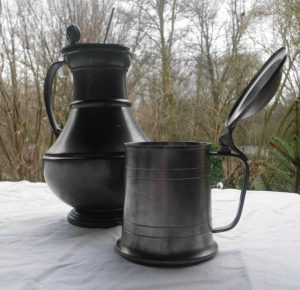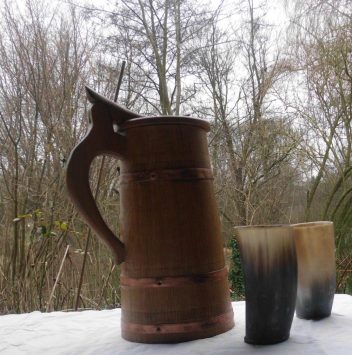
Fumbling for Terroir
Volker Bach examines what Renaissance German beer culture can teach us about an elusive concept
In 1575, the German lawyer and beer connoisseur Heinrich Knaust published Five Books on the Divine and Noble Gift, the Philosophical, Precious and Wonderful Art of Brewing Beer [1]. In it, he writes:
“Regarding flavour, there is very great difference among beers, for above the common flavour of all beers, some are sweet, some slightly bitter, some partly sharp, some have a wine-like (weinlich) taste, …” (p. 67)
This book comes from a beer culture that thought of the origin of beers in terms very similar to the modern idea of terroir. Beers were traded as distinctive local products that connoisseurs understood intimately, certain varieties were chosen for specific occasions, and even illicit copying was a problem.
Of course, the idea that the origin can be used as a proxy for quality in food was not new then. Origin, however, is not quite the same as terroir. To the extent that this term can be defined – and neither the Larousse Gastronomique nor the Oxford Companion to Food do so – terroir is the result of all factors specific to a locality acting in concert. In a pre-scientific world view, it was the elemental makeup of a place and above all its water that defined its products. Knaust writes:
“The first and foremost matter of beers is water which one may drink, moist and cold, and which assumes the qualities of the things it is mixed and mingled with or with which it is boiled. […]
Water, though, is of many kinds and distinctions such as flowing water, lake water, well water, spring water and rain water. And though named waters are distinct, they may be all used conveniently in brewing, though one is better suited than another.
In many places on the shore, they also brew beer with water that is salty for want of fresh and sweet water. Similarly, beers are brewed from waters that taste of metal because they spring either next to or by mines or because other seams of the same material leach into them. …” (p. 50)
By contrast, his descriptions of barley, wheat and hops are brief and make no such distinctions. That water explains different qualities in food is an intuitive assumption even today. In an age where scientists believed all matter consisted of four elements – fire, water, earth and air – it would look even more compelling. Knaust sees the properties of beers from various locations linked to the place they are made in, and especially its water. He explains:
“Goslar beer has its name from the water that flows through Goslar which is called the River Gose. And though it is softer than Hamburg beer in substance, virtues and other temperaments, it is still nonetheless a good and delicious beer and well worthy of its praise. … It is sweet in the beginning, but afterwards with time it gains a winelike aftertaste like Hamburg beer does.“ (p. 81)
This assumption cannot explain all differences; he observes that even though Stade beer is made “…in all measure, manner and form as the Hamburg beer is brewed, from the same Elbe river, similarly using wheat, hops and all other things…” it is still not the same (p. 78). Ultimately, he concedes:
“Many brewers in other towns are trying to copy this beer (Gose) … but this fails still, because the Lord God has given each town and land its specific gifts and blessings so that each shall have its own nature as is described above.” (p. 82)

Interestingly, Knaust does not say much about differences in the production process. After a cursory description, he only refers to mistakes that harm the flavour such as under-boiling or over-hopping the wort. Instead, he provides long lists ranking beers, describing their taste, introducing their places of origin, sometimes referring to their medicinal properties or recounting amusing factoids.
Obviously, Knaust is wrong on the science. More interestingly, his views are at odds even with some things contemporaries knew. Notably, he does not address the changing qualities of cereals; grains varied in size, moisture and starch content depending on soil and weather. Because bread prices depended in part on this, cities ran tests to establish what weight of flour could be produced from a given volume of grain. It is hard to imagine that Knaust, a lawyer in the service of a city council, would not have known this. He would also have known that it did not make a good argument for terroir, though.
Beer produced for the market was not made by local grain farmers, it was produced in cities, usually by professional brewers and on a near-industrial scale. The two varieties Knaust singles out for the highest praise, Hamburg white (wheat) and Danzig red (barley) beer, both hailed from major ports where grain was traded in bulk. Hamburg beer is an especially striking example since wheat wasn’t grown in the region at all. Its brewers depended on the harvests of Saxony, Bohemia and Moravia shipped down the Elbe for hundreds of kilometres. Knaust knows this. He raises the question why the neighbouring town of Stade fails to produce a brew the equal of Hamburg’s himself, but instead of referring to craftsmanship, he credits divine providence.
It is not surprising that the author should adopt this perspective, given the social class he comes from. His is the view of the expert consumer, a worldly, wealthy man who has access to trade networks, the knowledge to select the best products of his world, and the means to afford them. As a jurist and municipal official, he counted among patrician burghers of Germany’s cities, a group whose status was founded on wealth and business acumen and whose income was derived to a large extent from trade. Strict laws separated them from the nobility, making investment in large estates impossible for most. A multitude of boundaries and local laws fragmented the financial market, and many rival princes ensured that neither capital nor political power ever concentrated in one place, limiting careers at court or in the civil service. Trade, especially in the coveted products of Germany’s famous craftsmen, was often the only way to accumulate riches, and even many who were not merchants by profession dabbled in buying and selling foodstuffs and livestock for profit. Urban artisans who often had the scope of their production curtailed by strict laws, resented the fact that no limits were placed on the stocks of the traders who bought their output. We need not accuse Knaust of deliberately erasing the importance of craftsmanship to appreciate how his view of things would have been convenient for him.
Knaust’s world of beer connoisseurship and emerging ideas of terroir ended through violence. The Thirty Years’ War and mercantilist policies of territorial princes all but extinguished long-distance beer trade. Instead of a local product, beer was now regarded as a commodity depending on skill and technology that could be transplanted.
That is not a bad thing. After all, Knaust was wrong; Hamburg white beer did not owe its quality to an elusive nature of place. It was the skill of the brewers in malting, drying, roasting and fermenting that produced its unique flavour [2]. What this shows is that we need to consider our perspective carefully when we speak of food and drink. Terroir as a concept is often useful, but we must not overlook the human factor. Saying things like “the soil of Burgundy produces hearty red wine” is simply wrong. People in Burgundy produce it.
All text and photographs © Volker Bach 2017
